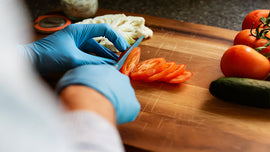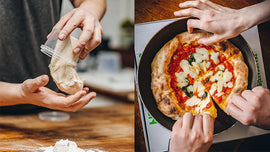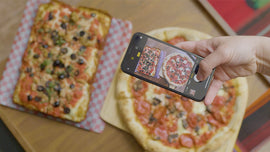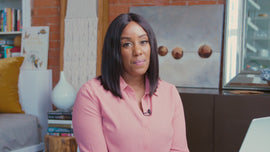-
I'm Samantha Renée. I help businesses grow and scale their businesses at Bricks to Clicks Collective. And I'm also a business tutorials producer at Shopify. Planning for the future seems impossible right now. And many restaurants are operating in survival mode. Surviving in a time like this takes grit, ingenuity, and sometimes a pivot to weather this storm.
-
So in this video, we'll discuss three restaurant pivoting strategies that keep you cooking and your customers happy. And we'll highlight and learn from actual restaurants who are using these strategies to pivot their business. The first strategy is about transitioning online and doubling down on what customers want.
-
As a restaurant owner, I'm sure you're used to making food, but not making websites. But as the whole world transitions into a new way of operating and interacting with each other, being online is more important than ever. It's definitely going to take your business a little more time and organization to get up and running online, like making sure that you have pictures of your food and descriptions of your menu items.
-
但一旦你有了这些东西,你可以in a day. And it doesn't have to be perfect right away. You can work out the kinks and find the best flow for your business. Take Happy Coffee and Wine, for example. They are small Toronto-based boutique coffee shop and wine bar. Their doors were only open for about eight months before they had to pivot their entire operation. With Instagram as their sole online presence prior to the pandemic, they quickly created a website and transitioned online.
-
They took product photos in the basement of their shop. From there, they started offering online wine and coffee orders for pickup and local delivery. With a pretty decent reach on Instagram, they were able to use their account and let people know how they were pivoting their business and direct them to their online store.
-
And with much higher inventory than before, they repurposed their brick and mortar wine bar into storage and packing areas. “So yeah, this used to be our wine bar. So obviously, people used to sit in these seats, and drink some wine. That used to be our wine fridge.
-
It is now very empty. And so yeah, we sort of repurposed all of our seating area too, because we don't really have space to put in enough shelving for a higher inventory operation up top. So we just sort of repurposed our bar space and seating area to accommodate for all of our wine inventory.
-
But we have obviously turned this into wine storage, as well.” While transitioning to online sales is one part of the strategy to keep your operations going, the other part is doubling down on what customers want. Some aspects of your restaurant might become less important at this time. So picking one area to focus on can really strengthen your offering to your customers.
-
Here's an example. Brodflour, an eatery that used to mainly focus on selling coffee, baked goods, and sandwiches, has now doubled down on selling flour! As bread-making became a popular quarantine activity, regular grocery stores have started to run out of flour.
-
So Brodflour started marketing themselves as an alternative, premium product. What they used to sell in a month for flour, they're now selling in two days. And that's not including wholesale customers. Here's Matt from Brodflour to give us a look at what their space looks like now.
-
“This is Matthew from Brodflour. What was once something that was geared towards our retail walk-in traffic has now become an area where we store grain and where we bag up flour. So as you'll see here, this challenging time has prompted us to be manufacturing much more flour and bread and as a result, we're dealing with the demand for increases in our wholesale channel.
-
So for example grocery stores, online delivery grocers, as well as online orders that we collect through Shopify. So as you can see, what once used to be a beautiful retail space is now primarily used for the manufacturing and shipping of our products.
-
For myself, my employees, what's changed is my day usually starts at about 5:00, where we start to gather wholesale orders for delivery, and it usually ends being covered in flour, as we are milling flour for the following days. Our employees as well have gone from being on the retail counter to helping us prepare and manufacture our wholesalers to go out.” So now that we've talked about transitioning to online sales, and focusing on one area of your business, let's talk about another strategy that some restaurants are using to keep their operations running: grocery delivery.
-
Recently, we've seen many restaurants who have pivoted their entire business model. Offering grocery delivery and high quality produce boxes is quite a 180 from running an eat-in restaurant. But by leaning in to connections that restaurants already have with produce providers, it's totally doable.
-
Take Mother Cocktail Bar, for example. Here's how they've teamed up with Ration Food Labs to run a restaurant and food delivery service. “Here at our local grocer, we just noticed that everything was super picked-through. And you know restaurants are fortunate enough to have you know high quality produce.
-
And we wanted to be able to offer that advantage to everybody. We set up a platform with Shopify, basically offering directly to door pantry and grocery service for those that people who are directly affected by COVID or who don't feel comfortable going outside.
-
We're teamed up with so many different vendors, suppliers, farmers, chefs. When you shop with us, everybody can be helped out.” OK. So now we've talked about two different ways restaurants have pivoted their businesses to weather this storm. The third and final strategy that we're going to talk about is how to offer meal kits and tutorials. By offering meal kits and instructions on how to cook, you're keeping your team working and you're developing a brand new relationship with your customers.
-
Livia Sweets is a cafe and restaurant that used this strategy to keep their doors open. Let's hear more about what they did. “After we realized that we could keep our doors open and also keep people safe, we realized that the online sales were the only way that we could keep afloat. Everything we were trying to think of had to be ways that kept the staff, using the skills that they already have.
-
So we're able to open up the takeout window, which is great. But a lot of you are still not comfortable coming up the window. So we realized people wanted to eat our bread. And they did not want to wait in line. So through Shopify, I put in the online ordering system. And then you can just pick up.
-
So that's working really well. We're selling a lot of bread through that. Instead of been open for dinner at night, we're doing pasta kits and that just allows us to keep our chef employed. So he's making these beautiful pastas so people can start to have the Livia experience at home and they're able to do that with the help of a video tutorial that we've got online as well.
-
People are really able to see sort of how that process works and still have a face for the product that they're getting.” We've covered a lot here. Before we finish, let's review the three strategies we've talked about and key takeaways. Strategy one: transition online and double down on one area.
-
Strategy two: grocery delivery. Strategy three: meal kits and tutorials. So we talked about how to transition to online sales. And how to double down on one area of your business, like flour. We talked about offering produce boxes and grocery deliveries and finally creating online tutorials to inspire and guide your customers.
-
So what are the main takeaways here? Number one, utilize existing relationships like Massimo from Mother Cocktail who tapped into existing relationships with produce vendors to offer grocery delivery. Number two, get started and iterate along the way.
-
Madeleine from Happy Coffee and Wine moved fast when regulations started to change. And they're tweaking their process as they learn along the way. Number three, take a pulse. Brodflour reacted to the trends and shortages around them by offering a solution.
-
Number four, try something new. Livia Sweets had never offered online tutorials before, but they tried something new which has allowed them to keep connecting with their customers. I really hope this was helpful and that you're feeling inspired to make a pivot, to keep you cooking.
-
For more tips and tutorials, check out some of the other content on Compass.























































































